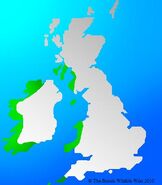The Chough (Pyrrhocorax pyrrhocorax), is a bird in the crow family
This bird has glossy black plumage, a long curved red bill, red legs, and a loud, ringing call. It has a buoyant acrobatic flight with widely spread primaries. The Chough pairs for life and displays fidelity to its breeding site, which is usually a cave or crevice in a cliff face. It builds a wool-lined stick nest and lays three eggs. It feeds, often in flocks, on short grazed grassland, taking mainly invertebrate prey.
Although it is subject to predation and parasitism, the main threat to this species is changes in agricultural practices, which have led to population decline and range fragmentation in Europe; however, it is not threatened globally.
Description[]
The adult of the nominate subspecies of the Chough, is 39–40 centimetres (15–16 in) in length, has a 73–90 centimetres (29–35 in) wingspan, and weighs an average 310 grammes (10.9 oz). Its plumage is velvet-black, green-glossed on the body, and it has a long curved red bill and red legs. The sexes are similar (although adults can be sexed in the hand using a formula involving tarsus length and bill width) but the juvenile has an orange bill and pink legs until its first autumn, and less glossy plumage.
The Chough is unlikely to be confused with any other species. Although the Jackdaw share its ranges, the Jackdaw is smaller and has unglossed grey plumage.
The Chough's loud, ringing chee-ow call is clearer and louder than the similar vocalisation of the Jackdaw, and always very different from that of its yellow-billed congener, which has rippling preep and whistled sweeeooo calls. Small subspecies of the Red-billed Chough have higher frequency calls than larger races, as predicted by the inverse relationship between body size and frequency.
Distribution and habitat[]
The Chough breeds in Ireland, Great Britain, the Isle of Man, southern Europe and the Mediterranean basin, the Alps, and in mountainous country across Central Asia, India and China, with two separate populations in the Ethiopian Highlands. It is a non-migratory resident throughout its range.
In Ireland, Great Britain and Brittany it also breeds on coastal sea cliffs, feeding on adjacent short grazed grassland or machair. It was formerly more widespread on coasts but has suffered from the loss of its specialised habitat. It tends to breed at a lower elevation than the Alpine Chough, that species having a diet better adapted to high altitudes.
Behaviour and ecology[]
Breeding[]
The Chough breeds from three years of age, and normally raises only one brood a year, although the age at first breeding is greater in large populations. A pair exhibits strong mate and site fidelity once a bond is established. The bulky nest is composed of roots and stems of heather, furze or other plants, and is lined with wool or hair. The nest is constructed in a cave or similar fissure in a crag or cliff face. In soft sandstone, the birds themselves excavate holes nearly a metre deep.
The Chough lays three to five eggs 3.9 x 2.8 centimetres (1.5 x 1.1 in) in size and weighing 15.7 grammes (0.55 oz), of which 6% is shell. They are spotted, not always densely, in various shades of brown and grey on a creamy or slightly tinted ground. The egg size is independent of the clutch size and the nest site, but may vary between different females. The female incubates for 17–18 days before the altricial downy chicks are hatched, and is fed at the nest by the male. The female broods the newly hatched chicks for around ten days, and then both parents share feeding and nest sanitation duties. The chicks fledge 31–41 days after hatching.
Juveniles have a 43% chance of surviving their first year, and the annual survival rate of adults is about 80%. Choughs generally have a lifespan of about seven years, although an age of 17 years has been recorded. The temperature and rainfall in the months preceding breeding correlates with the number of young fledging each year and their survival rate. Chicks fledging under good conditions are more likely to survive to breeding age, and have longer breeding lives than those fledging under poor conditions.
Feeding[]
The Chough's food consists largely of insects, spiders and other invertebrates taken from the ground, with ants probably being the most significant item. Although invertebrates make up most of the Chough's diet, it will eat vegetable matter including fallen grain.
The preferred feeding habitat is short grass produced by grazing, for example by sheep and rabbits, the numbers of which are linked to the Chough's breeding success. Suitable feeding areas can also arise where plant growth is hindered by exposure to coastal salt spray or poor soils. It will use its long curved bill to pick ants, dung beetles and emerging flies off the surface, or to dig for grubs and other invertebrates. The typical excavation depth of 2–3 cm (0.8–1.2 in) reflects the thin soils which it feeds on, and the depths at which many invertebrates occur, but it may dig to 10–20 cm (4–8 in) in appropriate conditions.
